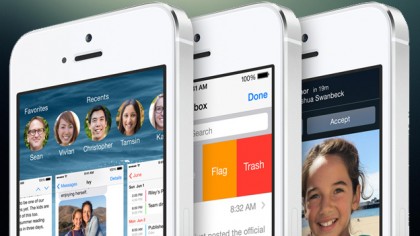From iPhone OS to iOS 8: just how has Apple's mobile platform changed?
Did you even remember it was called iPhone OS?
iOS 5

iOS 5 made its debut on the iPhone 4S, as well as appearing on the iPad 2. Amongst updates came the ability to use the volume keys as a Camera shutter button, quick access to the camera from the lock screen by double tapping the home button, and a completely PC-free experience, so no longer would you be tied to iTunes with wires to update the OS.
Safari also had an update to bring in Reader and tabbed browsing. The Notifications Centre made its first appearance, with Messages, App Updates, Calendar events and so on all now grouped together and accessible by dragging down from the top and the lock screen.
iMessage was also introduced, in a bid to challenge BBM, which was still the dominant messaging platform at the time. Apple's offering, alongside third-party options such as WhatsApp, now rule the messaging ecosystem.
Above all, iOS 5 will be remembered for one thing: Siri. Siri is synonymous with mobile voice assistants, and with every update becomes more and more useful. It allowed users to send messages, play songs or playlists, create reminders, and could even give a weather forecast.
iOS 6

Launched on the iPhone 5, and appearing on the iPad 3, iPad 4 and the iPad Mini, iOS 6 can be remembered for two words: Apple Maps.
Yes, Apple Maps brought turn-by-turn navigation, and wiped Google Maps off iOS, but it was a disaster, mocked even by Motorola.
Even Apple's attempt at a clock app landed it in hot water, after the Swiss Rail Network proved the design was too similar to its own.
Sign up for breaking news, reviews, opinion, top tech deals, and more.
Other than Apple Maps, the big news from iOS 6 was Do Not Disturb, a mode that enabled you to silence calls and notifications, ideal for sleeping meetings, although even that hit problems when it refused to auto-disengage in early 2013.
FaceTime finally became 3G enabled, Panoramas were added to the camera, and Apple's Passbook app popped up too, combining vouchers and tickets in a handy place. Safari's Reader update from iOS 5 also gained offline support, while Siri was announced for the iPad 3.
iOS 7

iOS 7 is now almost one year old - hasn't time just flown by? It arrived with a cacaphony of new features and colourful updates, and included a radically overhauled interface, new Control Center, transparent animations and more.
When iOS 7 landed on devices many people lost their minds, complaining about the lurid colour scheme and the new interface design - demanding Apple revert back to iOS 6 stylings.
A year on though and those initial cries of angst have all but disappeared and iOS 7 has been accepted as a clean, fluid and refreshing update to the iPhone line.
Lots of people were rightly angry about Apple ditching Google data, but beyond that mis-step there's a lot to like: a more useful Siri (App launching plus the recognition that a world exists outside of the USA), shared Photo Streams, handy Phone app controls such as 'send to voicemail', and major improvements to Mail, Safari, accessibility and the Camera app.
However, with the new iOS 7 update we've been given the all-new interface, as well as new ways to control the phone and make sure that you don't have to worry about fumbling around in the dark for the torch.
iOS 8

The latest update from Apple is iOS 8 and it's waiting in the wings to jump onto the new iPhone 6 (and possibly iPhone 6L) as well some of Apple's older devices
You'll need an iPhone 4S or newer or an iPad 2 or newer to update to the latest software, plus the 5th generation iPod will also get a taste of iOS 8.
So what are the big features you get with iOS 8? Apple is opening up its TouchID fingerprint scanner to developers, allowing them to include the security recognition in their apps - which will be great for banking and payment apps especially.
The Health app is another major addition in iOS 8, as Apple looks to collate data from your various health and fitness devices and apps to display in one unified location. This gives you an overview of your health, and saves you jumping between a number of apps to find out different things.
You'll also be able to send and receive SMS messages from your iPad or Mac, as well as make and receive phone calls when they are linked to an iPhone.
There's more too, including the addition of video and voice options to group messaging, interactive notifications, a new Quicktype (read: Swype rival) keyboard, location based lockscreen apps, plus updates to Siri and Spotlight.
- Here's our updated review of iOS 8